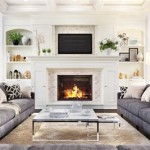How to Design Home Decor: A Comprehensive Guide
Designing home decor involves a systematic and thoughtful approach to creating aesthetically pleasing and functional living spaces. Effective home decor transcends mere superficiality; it encompasses a holistic understanding of the inhabitants' lifestyles, preferences, and needs. This article explores key principles and practical strategies for achieving successful home decor.
Understanding the Foundations of Design
Before embarking on any practical decorating, a foundational understanding of design principles is paramount. These principles provide a structured framework for making informed decisions and achieving a cohesive and harmonious result. Core concepts include: balance, proportion, rhythm, emphasis, and unity.
Balance: This refers to the distribution of visual weight within a space. Balance can be symmetrical (formal), asymmetrical (informal), or radial (organized around a central point). Symmetrical balance provides a sense of order and stability, while asymmetrical balance offers a more dynamic and contemporary feel. Radial balance is less common in general home decor but can be effectively employed in specific areas, such as around a dining table or chandelier.
Proportion: Proportion concerns the relationship between the sizes of different elements within a room. The golden ratio (approximately 1:1.618) is often cited as a guideline for achieving harmonious proportions. For example, when arranging furniture, consider the size of the objects relative to the dimensions of the room and to each other. Avoid overcrowding a small space with overly large furniture or using undersized accessories in a vast room.
Rhythm: Rhythm creates a sense of movement and visual interest within a space. This can be achieved through repetition, progression, transition, or contrast. Repeating colors, patterns, shapes, or textures throughout a room can establish a sense of continuity and cohesiveness. Progression involves a gradual change, such as a series of progressively smaller paintings on a wall. Transition refers to a smooth flow from one element to another, often achieved through curved lines or gradual color changes. Contrast, the juxtaposition of differing elements, adds visual drama but should be used judiciously to avoid overwhelming the senses.
Emphasis: Emphasis involves creating a focal point that draws the eye and provides a sense of direction for the viewer. This could be an architectural feature, such as a fireplace or a large window, or a carefully chosen piece of furniture or artwork. Once a focal point is established, other elements in the room should support and complement it, rather than compete with it.
Unity: Unity is the overarching principle that ties all other elements together, creating a sense of wholeness and harmony. Achieving unity involves thoughtfully considering how all the different components of a room interact and relate to one another. This requires careful consideration of color palettes, materials, styles, and overall theme.
Color Palette Development and Implementation
Color is a powerful tool in home decor, capable of influencing mood, creating visual impact, and defining the overall aesthetic of a space. Selecting and implementing a well-considered color palette is crucial for achieving successful home decor. The first step involves determining the desired mood and atmosphere for the space. Warm colors (reds, oranges, yellows) tend to create a sense of energy and warmth, while cool colors (blues, greens, purples) evoke feelings of calmness and serenity. Neutral colors (whites, grays, beiges) provide a versatile backdrop that allows other elements to take center stage.
Once the desired mood is established, it is imperative to develop a cohesive color palette. There are several approaches to this: monochromatic, analogous, complementary, and triadic. A monochromatic palette uses different shades and tints of a single color, creating a subtle and sophisticated look. An analogous palette utilizes colors that are adjacent to each other on the color wheel, resulting in a harmonious and balanced scheme. A complementary palette incorporates colors that are opposite each other on the color wheel, creating high contrast and visual drama. A triadic palette uses three colors that are equally spaced on the color wheel, offering a more vibrant and dynamic look.
Implementing the chosen color palette involves carefully considering how colors will be used on walls, furniture, textiles, and accessories. As a general rule, it is advisable to use a neutral color for the majority of the wall space, then layer in accent colors through furniture, artwork, and decorative items. The 60-30-10 rule is a useful guideline: 60% of the room's color should be the dominant color, 30% should be a secondary color, and 10% should be an accent color. This ratio helps to create a balanced and visually appealing space. Lighting also plays a crucial role in how colors are perceived; different types of lighting (natural, incandescent, fluorescent, LED) can significantly alter the appearance of colors.
Furniture Selection and Spatial Arrangement
Selecting appropriate furniture and arranging it effectively are essential components of successful home decor. Furniture should be both aesthetically pleasing and functional, reflecting the inhabitants' lifestyles and meeting their specific needs. Before purchasing any furniture, it is critical to measure the space and create a floor plan. This will help to ensure that the furniture fits comfortably and that there is adequate space for movement. Consider the traffic flow through the room and arrange furniture accordingly to avoid creating bottlenecks or obstacles. Prioritize functionality.
Choosing the right size and style of furniture is crucial. Large, bulky furniture can overwhelm a small space, while undersized furniture can look out of place in a large room. The style of furniture should complement the overall design aesthetic of the home. Mixing different styles can create a more eclectic and personalized look, but it should be done thoughtfully and with careful consideration of the overall harmony of the space. For example, pairing a contemporary sofa with antique side tables can create an interesting contrast, but ensuring that the pieces share a common color or texture will help to tie them together.
Arranging furniture effectively involves creating a sense of balance and visual interest. Consider the focal point of the room and arrange furniture to draw attention to it. Create conversational groupings by arranging seating around a coffee table or fireplace. Ensure that there is adequate space between furniture pieces to allow for comfortable movement. Use rugs to define different zones within a room and to anchor furniture groupings. Experiment with different arrangements until a layout is achieved that is both functional and aesthetically pleasing.
Lighting Strategies for Ambiance and Functionality
Lighting is a crucial element often overlooked in home decor. A well-designed lighting scheme enhances the aesthetics of a space, highlights its architectural features, and provides practical illumination for various activities. A comprehensive lighting plan should incorporate three primary types of lighting: ambient, task, and accent.
Ambient lighting, also known as general lighting, provides overall illumination for the room. It should be sufficient to allow people to move around safely and comfortably. Sources of ambient lighting include ceiling fixtures, recessed lighting, chandeliers, and wall sconces. The intensity of ambient lighting should be adjustable to accommodate different moods and activities. Dimmers are essential for creating a flexible and adaptable lighting scheme. Natural light should also be maximized; using sheer curtains or blinds can allow ample daylight to enter the room while still providing privacy, and the placement of mirrors can enhance the natural light in a space.
Task lighting provides focused illumination for specific activities, such as reading, cooking, or working. Sources of task lighting include desk lamps, under-cabinet lighting, and floor lamps. Task lighting should be bright enough to prevent eye strain but not so harsh as to create glare. Adjustable lamps are ideal for providing customized illumination for different tasks.
Accent lighting is used to highlight specific features or objects within a room, such as artwork, architectural details, or decorative accessories. Sources of accent lighting include track lighting, spotlights, and uplighting. Accent lighting adds visual interest and drama to a space. The choice of light bulbs is also important. Different types of light bulbs (incandescent, halogen, LED) produce different colors of light. Warm light (2700-3000K) creates a cozy and inviting atmosphere, while cool light (4000-5000K) provides brighter and more crisp illumination. LED bulbs are energy-efficient and long-lasting, making them a sustainable choice for home decor.

13 Creative Home Decor Ideas Design Cafe

13 Creative Home Decor Ideas Design Cafe

How To Design A Room Like An Interior Designer Step By Greenhouse Studio

Home Decor Ideas Expert Shares Interior Design Tips For Beginners Hindustan Times

Living Room Decor Ideas For Your Home Design Cafe

77 Best Living Room Decor Ideas 2025 Unique

100 Home Decor Ideas The Ultimate Inspiration For Interior Designers

8 Interior Design Channels For Home Décor Tips Perry Homes

Low Budget Home Design Affordable Decor Ideas For Every
:strip_icc()/cdn.cliqueinc.com__cache__posts__204854__interior-design-advice-204854-1513278007700-fb.700x0c-98a61e8ff37f4c21abbfbbe4284aa134.jpg?strip=all)
10 Mistakes That Look When Decorating Your Room
Related Posts







